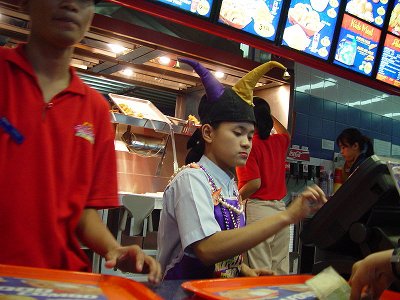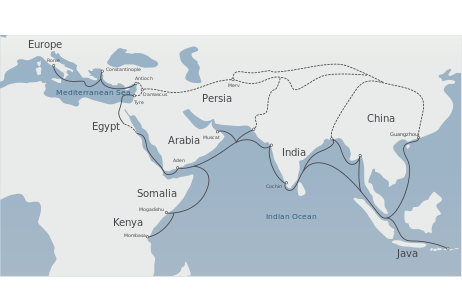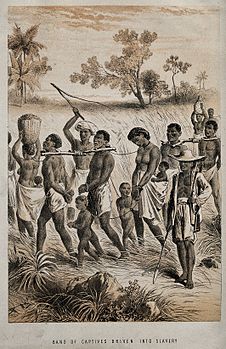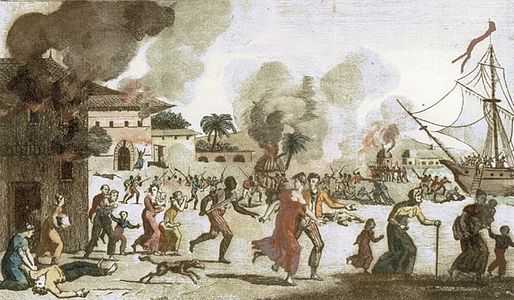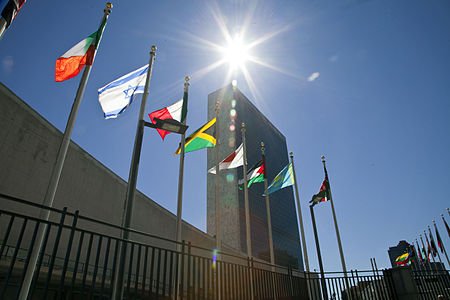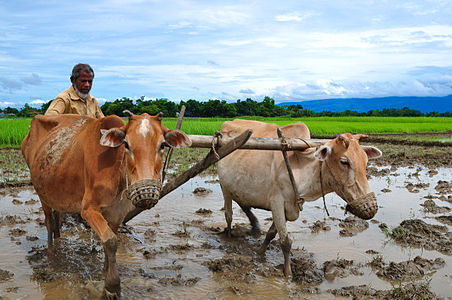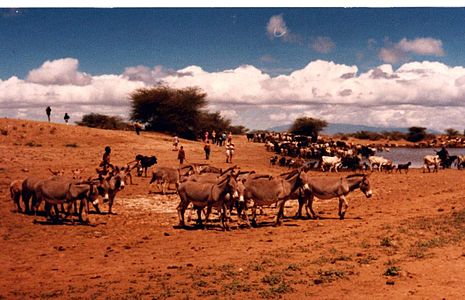Cultural Anthropology/Globalization
Contents
Unit 3: Globalization, Modernization & Development
Key Word & Concepts
Globalization
Modernization
Colonialism
Dehumanization
Primary commodity production
Export monoculture
Neocolonialism
Cultural Imperialism
Development
Underdifferentiation
Overinnovation
Culture fit
Development aggression
Introduction
We talk about globalization today as if it’s some great big new thing that we’ve all just discovered. But there’s really nothing new about it. ~ Jacqueline Winspear
In this section, we will skim the surface of globalization with a particular emphasis of the history of the modern era of globalization and its effects on indigenous peoples. Modern economic and political development is driven by the assumption that modernization and development will be beneficial for all people; however, cultural differences are not taken into consideration, often leading to the destruction of indigenous cultures. Understanding the context of modern development enables us to understand our own place in an increasingly interconnected world.
Start with this TedTalk video from Wade Davis, professor of anthropology at the University of British Columbia, speaking about endangered cultures [run time: 22.04].
What is globalization?
The answer to this question is not a simple one. There are various definitions of globalization depending on the perspective with which the topic is approached. Many think of globalization as processes that cause changes that make people more interconnected and interdependent. Others think of it as “…a reorganization of time and space in which many movements of peoples, things, and ideas throughout much of the world have become increasingly faster and effortless (Morris 2010: 865). Still others focus on the interaction and integration promoted by international trade, investment, and information technology (The Levin Institute 2015). Anthropologists acknowledge that all of these definitions are relevant to the study of globalization and use long-term ethnographic studies to understand the dynamics of globalization. One of the things that make anthropological research on globalization important is that it remains focused on the impact of these global processes on individuals and cultures. Anthropologists do not assume that globalization is “natural and unavoidable” as that approach is steeped in Social Darwinist ideology and obscures how power and privilege are constructed and maintained (Morris 2010). It is an experiential process, meaning that it is different for each person. In an anthropological sense, globalization is “…an intensification of global interconnectedness, suggesting a world full of movement and mixture, contact and linkages, and persistent cultural interaction and exchange” (Inda and Rosaldo 2002: 2).
Enmeshed in the concept of globalization are modernization, development, and the legacy of European colonialism.
Modernization
What it means to be modern is a concept that has changed over time. In the 5th century AD, Roman converts to Christianity used term to differentiate themselves from “barbarians.” Barbarians were non-Christian peoples, particularly people of the Jewish faith. During the Renaissance to be modern one had to cultivate a lifestyle based on classical Greek and Roman civilizations, while in the Enlightenment period rationalism, science-based knowledge, and the pursuit of “progress” was the hallmark of modernity. What all of these definitions have in common is that the people in power defined what it meant to be modern. This practice continues today with “modern” being synonymous with the Western industrial world led by the United States. Time must be reckoned in a linear manner; scientific knowledge and legal-rational institutions reign supreme. Technology, a capitalist economy, and a democratic political system are considered characteristics of modernity. Modernization then is a process of cultural and socio-economic change whereby less developed countries (LDCs) acquire characteristics of western, industrialized societies. It should be noted that this definition is used primarily by European-derived cultures. Modernization implies that other societies should be more like “us;” otherwise, that society is inferior. This is the legacy of European colonialism.
Legacy of Colonialism
In a broad view, colonialism, like globalization, is not new. Since the first hominins left Africa some 1.8 million years ago, humans have been colonizing the earth. Sometimes that movement across the globe involved people encroaching on areas already inhabited by other humans. Archaeologists have been documenting the movement of peoples throughout prehistory and history, using a variety of data to reconstruct what those interactions may have looked like. Colonialism refers to the domination of one culture, society, or nation over another. In the context of modern globalization and to oversimplify, colonialism specifically refers to Western European domination over much of the world starting in the fifteenth century, but the origins of that movement is in the Asian overland-trade routes previously established. In the remainder of this article, any reference to colonialism refers specifically to Western European colonialism.
The process of colonialism left a legacy that infuses modern globalization. As Western European nations overtook control of various areas, leaders and merchants moved many indigenous peoples from their homelands to solve labor shortages faced by the colonial powers. The African slave trade is the example that comes to mind for most people, but other peoples were also enslaved, e.g., Chinese and Indian. The slave trade was possible because there was a belief that anyone not living in the manner of Western Europeans was inherently backward or lesser than white Europeans. This dehumanization, or denial of humanness, was essential to colonial practices as it provided a justification for aggressive and morally questionable practices (Haslam et al. 2007). We can still see the effects of this ideology today in various social movements such as Occupy and the green movement.
Under European colonial rule, political and economic systems were reorganized. High-status Europeans were in charge of the colonies. By the end of the nineteenth century, colonial administrations were self-financing systems. Local indigenous leaders were bribed with titles, land, and tax breaks. This created an atmosphere of privilege that would create problems after decolonization. Local leaders then helped colonial administrators to force the local population in to a capitalist economic system. Primary commodity production, or the production of raw materials, became the enforced norm, undermining traditional crafts and mixed farming systems. Following the pattern of the forced-enclosure movement in Europe where communal lands were enclosed and used privately for the production of market-based agriculture, farmers were forced into growing cash-crops instead of growing crops for personal use. A culture of export monoculture where a country produces one or more primary commodities became established, a practice that is still at the heart of international trade today. South Africa became known for gold and diamonds, Mexico for corn, and, India for cotton, tea, peanuts, and sugar cane. As a result of this reorganization, many indigenous farmers lost their land to commercial agricultural production. Men were frequently removed from their homes to work on these industrial farms in order to meet the growing demands for goods of European urban populations. The families left behind struggled to make ends meet. Malnutrition and social unrest grew among indigenous groups.
Colonial administrators rarely acknowledged traditional female gender roles if they did not mirror the female gender role in Europe, which stated that women were the property of men, either their fathers or husbands. In areas where women had property rights, they were ignored by the colonial powers. In Kenya, Kikuyu women had rights to inherit land. After European domination, men were removed to work on European-owned farms and the land assumed to be owned by those men confiscated. Women lost control of the ability to grow sufficient food for their families and lost their status, wealth, and authority.
The loss of self-governance and status, disruption of gender roles and family, and the loss of resources led to social unrest as large segments of indigenous populations were enslaved, killed, or died due to disease. Decolonization movements began in Haiti in 1791. The Haitian revolt was started by slaves on sugar plantations and was the only slave revolt to result in the founding of a state. Independence movements gained momentum over time, spreading to Latin America, Asia, and Africa even as late as the 1990s (South Africa). After the end of World War II, colonial subjects who had fought in the war returned with the ideologies of freedom and self-determination. As colonies gained their independence, new leaders were expected to operate on the global stage in the same manner as and with their former colonial rulers in order to be considered legitimate. Frequently, people gained power in the newly independent states due to bribery or having some relationship to the former powers. Many newly emerged states required economic stimulation that was proscribed by the only nation that had economic growth during WWII, the United States. This model of economic development is sometimes referred to as neocolonialism; in other words, the new states were closely tied to former colonial powers economically.
We still see the lingering effects of colonial cultural imperialism, or expansion of one culture at the expense of others, in the languages, customs, and worldviews of former colonies. In Haiti, French is the national language; in Brazil, Portuguese. Spanish is spoken in most South and Central American countries, English in a wide-geographic distribution resulting from that nation’s imperialist expansion.
Development
In this context, development refers to “change directed toward improving human welfare” (Miller 2011: 260). What this definition fails to mention is that the change is based on a model developed by former colonial powers the result of which is “dislocated cultural space” (Inda and Rosaldo 2002:25). While western culture has historically taken precedence through the process of colonialism, in more recent years that dominance has been challenged resulting in interconnected cultural space (Inda and Rosaldo 2002:26).
Post WWII, development focused on rebuilding countries devastated by the global conflict. Impacting the course of development were two polarizing social ideologies: communism and democracy. Much of the economic and political development pursued by the United States was geared toward stopping the spread of communism. The goal was to help underdeveloped countries, or countries that did not economically use all their available resources to the degree deemed appropriate by the former colonial powers, become modern. The assumption was that all countries were on a universal path to modernity, an idea straight out of eighteenth century philosophies like social evolution (recall the theories section from the beginning of the quarter) and Social Darwinism. Several institutions were started to aid in development, particularly on the economic level: United Nations (UN), World Bank (WB), and International Monetary Fund (IMF).
The UN was chartered in 1945 with fifty-one countries as original members. The UN and its family of organizations work to promote respect for human rights, protect the environment, fight disease, foster development, and reduce poverty. It oversees progress and works to foster cooperation among nations. The UN has also become a “neutral” peacekeeper in more recent years, but it is totally dependent upon member nations to provide military and financial resources to fulfill its mission. The UN currently has 193 member states each of which has a single vote in the General Assembly. The UN Security Council, which is responsible for overseeing international peace and security, has fifteen members: five permanent members (China, France, Russian Federation, United Kingdom, and United States) and ten non-permanent members who are elected for a term of two-years by the General Assembly. Any nation can take part in discussions of the Security Council, but only the fifteen members have a vote. A student of history might recognize that the five permanent members of the Security Council were allies during WWII and represent the two post-WWII social ideologies mentioned above.
At the same time that the UN was being organized, it was decided that an international banking system was integral to reconstruct the post-war world economy. In July 1944 at Bretton Woods, NH, a conference of forty-four financial ministers from Allied nations met to discuss the rebuilding of the world economy. The United States encouraged the foundation of the “twin sisters” – the World Bank and International Monetary Fund. The WB focused on making loans to governments in order to rebuild railroads, highways, bridges, ports, and other infrastructures. Its initial focus would be on rebuilding Western Europe and Japan, and then the focus would shift to the underdeveloped world. Currently, the WB has 189 member countries, or shareholders, each of which is required to be a member of the IMF as well. Those members with the largest shares tend to have more influence in both institutions. The IMF’s initial goal was to stabilize international currency exchange. In 2012, the IMF’s mandate was modified to include economic and financial issues related to global stability.
The WB and IMF come under harsh criticism for their lending practices. In order to borrow money from the IMF or WB, debtor countries must agree to implement structural adjustment policies “…ensure open market access for corporations while cutting social spending on programs such as education, health care, and production credits for poor farmers” (Global Exchange 2011). Debtor countries must also privatize publicly owned utilities and industries. Critics claim that the institutions are setting social and economic policy without representation by elected representatives.
Why was all this control deemed necessary? Walt Rostow, a preeminent development economist remarked in 1956 that the natural resources located in underdeveloped nations should be kept safe from Communist control in order for the United States, Western Europe, and Japan to maintain their way of life.
Development Models
Since the end of WWII, models of development have changed based on political, economic, and social needs. The earliest development models were developed using several assumptions:
- The model works anywhere; it can be universally applied without regard to specific cultural patterns – this is referred to underdifferentiation, or the failure to recognize that cultural norms vary.
- Non-monetary systems are “backward.” Any economic exchange that did not rely on the market system was inherently inferior. Modernization = monetization. Traditional lifeways were viewed as an impediment to development because wealth was often community based and not individually based.
- There is a common destiny of society and the common good arises out of the pursuit of individual self-interests.
- Living standards can be quantified with a monetary index, e.g., Gross National Product (GNP) and life expectancy. Basically, they assumed that wealth is equal to happiness.
Modernization Model: This model is focused on change through economic growth. It is the basic model outlined above in the background information on the World Bank and International Monetary Fund. Material progress through industrialization, market expansion, and technological innovation are key components as is a democratic political system with consolidated power vested in the state. Material progress would result in better lives for the citizenry even if the environment and society suffered. Critics of this cookie-cutter approach to development claim that it is not sustainable because of the high consumption levels of resources. Anthropological research indicates that this model is detrimental to indigenous peoples as their land and resources are subsumed by the state and sold or leased to corporations for resource extraction, leading to destruction of their cultures. This model also encourages reduction in both cultural and bio-diversity (Miller 2011). See Optional: Further Reading for information on specific studies.
Growth-Oriented Development Model: Drawing on the modernization model and Rostow’s stages of growth theory (see Rostow’s Theory of Modernization Development https://www.academia.edu/3596310/Rostows_theory_of_modernization_development), the growth-oriented development model proposes that a trickle-down effect will occur when there is investment in economic growth. As wealth increases for those investing in economic growth, some of the wealth will make its way down to those less well off thereby positively impacting human welfare. Participation in the international market and industrialization of both agriculture and manufacturing are key elements. Privatization of public services is also imperative. This may be familiar as these ideas are incorporated in the World Bank and IMF structural adjustment policies (Miller 2011). One of the criticisms of this model is that it ignores the fact that “underdeveloped nations” did not have a history of development. Such is not the case. Many indigenous societies had well-established trade with other groups both close by and long distance. There were also lucrative indigenous industries such as the Indian textile industry mentioned previously. This model concentrates resources into the hands of the few creating marked inequality in society. Recent research and criticism focuses on the unsustainability of this model of development.
Distributional Development Model: Growing out of criticism of the trickle-down effect, the distributional development model is concerned with social equity. The distributional development model claims that no development program will work without ensuring that there is equitable access to resources for all (Miller 2011).
Human Development Model: In this model, the focus is on investment in human welfare, better education, health care, security, and safety, with the belief that it will lead to economic growth (Miller 2011).
Sustainable Development Model: Probably the most recent development model, sustainable development focuses on the conservation of non-renewable resources and, in some cases, survival of indigenous peoples. This model also proposes investment in development projects that are financially sustainable over time.
Indigenous Development Model: Indigenous development models draw on local cultural practices to promote realistic change and not overinnovation (too much change in daily life).
What is clear is that the development projects that work best are socially compatible and recognize that the economy is part of a culture and not a separate entity. Culture fit or the practice of “…taking the local culture into account in project design” (Miller 2011: 369) is at the heart of a development project failure in rural Bangladesh. A farming cooperative program with support from the government was begun with adult males, ignoring the traditional role of women in farming practices (male bias in development is common) and requiring the use of crop seeds, fertilizers and pesticides. Over time, the pesticides entered the food chain through seepage into local rivers and streams, which then were absorbed by fish and eventually people, causing an increase in birth defects. The local people noticed that their livestock became sick and died after the increased use of pesticides for farming. The people rejected the development program after some years and returned to their traditional ways of organic farming, sparking a “new agricultural” movement, Nayakrishi, with the help of the Center for Development Alternatives, a non-governmental organization based in Dhaka, the capital of Bangladesh (McKibben 2001). Since the Nayakrishi began over 300,000 Bengali families have returned to organic farming and development projects focused on culture fit like that of Hunger Free World (http://www.hungerfree.net/english/whatdo/bangladesh/lcbd.html ) have been successful.
In East Africa, the World Bank sponsored an irrigation and settlement project geared to transform local pastoralists into small-scale sedentary farmers. Pastoralists were expected to simply abandon their traditional way of life and their territory turned over to new commercial farms. While this would have benefitted the commercial farmers it required the pastoralists to work “…three times harder growing rice and picking cotton for the bosses,” a case of overinnovation (Kottak 1990: 725). This project failed and was canceled and redesigned. World Bank projects in South Asia, South America, the Middle East, and West Africa also failed when culture fit was not considered. Unfortunately, there are numerous development projects that result in the loss of land and resources for local, indigenous populations; from hydroelectric dams and logging (Kayapo, Amazon rainforest) to fish-processing factories in pastoral areas of Kenya and international trade agreements like the North American Free Trade Agreement - NAFTA (Zapatista, Mexico), traditional lifeways are at risk due to development aggression, the “imposition of development projects and policies without the free, prior, and informed consent of the affected people (Miller 2011: 377).
Anthropology and Development
Anthropologists specializing in development studies may call themselves applied anthropologists, economic anthropologists, environmental anthropologists, ecological anthropologists, or development anthropologists. Anthropological approaches to development are important because,
…[anthropology provides] the analytical means to understand the heterogeneity of loca/ actors and their interests, to see the multiple links in their social lives and appreciate their everyday strategies, to tap into local understandings and comprehend resistance to perceived outside interference (Sillitoe 2007: 154 quoted in O’Driscoll 2009: 17).
While anthropology might not have a monopoly on insight into multidisciplinary approaches or insight into the benefits of including indigenous knowledge, it is at the forefront of anthropological approaches. Involvement in development projects may create an ethical dilemma for anthropologists, as the tenet that is drilled into every anthropology student’s head is not to change the cultures we study and to do no harm. As outlined above there are development projects that do not help people in the way that the planners envision. Frankly, it is not uncommon for the interests of development planners and local peoples to conflict. Some argue that it is imperative for anthropologist to be involved in development discourse to work with local people to help them assess their needs and ideas for change or to even advocate for localized, community-specific initiatives. Some anthropologists suggest that we should not be involved with international development agencies, but only with indigenous rights movements. Still others suggest that anthropologists study both small and large development institutions in order to better understand the development system. Anthropological data can help development projects maximize social and economic benefits by ensuring projects are a cultural fit, respond to local needs, involve the appropriate local social actors and organizations in the project, and are flexible (Gezen and Kottak 2014).
Optional: Further Reading
Chollett, Donna L. Neoliberalism, Social Exclusion, and Social Movements. Lanham, MD: Lexington Books, 2013.
Corbridge, Stuart and Alpa Shah, eds. The Underbelly of the Indian Boom. London: Routledge, 2015.
Crate, Susan A. Cows, Kin, and Globalization: An Ethnography of Sustainability. Lanham, MD: AltaMira Press, 2006.
Dentan, Robert Knox, Kirk Endicott, Alberto G. Gomes, and M. B. Hooker. Malaysia and the “Original People”: A Case of Study of the Impact of Development on Indigenous Peoples. Boston: Allyn and Bacon, 1997.
Edelman, Marc. Peasants Against Globalization: Rural Social Movements in Costa Rica. Stanford, CA: Stanford University Press, 1999. Ford, Lisa and Tim Rowse. Between Indigenous and Settler Governance. London: Routledge, 2014.
Fratkin, Elliot M. Ariall Pastoralists of Kenya: Surviving Drought and Development in Africa’s Arid Lands. Boston: Allyn and Bacon, 1998.
Freeman, Milton M. R., Ingmar Egede, Lyudmila Bogoslovskaya, Igor I. Krupnik, Richard A. Caulfield, and Marc G. Stevenson. Inuit, Whaling, and Sustainability. Walnut Creek, CA: AltaMira Press, 1998.
Gomes, Alberto. Modernity and Malaysia: Settling the Menraq Forest Nomads. London: Routledge, 2010.
Olsen, Kjell. “When Ethnic Identity Is a Private Matter.” Journal of Ethnology and Folkloristics 1, no. 1 (2007): 75-99.
Rudiak-Gould, Peter. Climate Change and Tradition in a Small Island State: The Rising Tide. London: Routledge, 2013.
Sahoo, Ahaya Kumar and Gabriel Sheffer, eds. Diaspora and Identity: Perspectives on South Asian Diaspora. London: Routledge, 2015.
Sejersen, Frank. Rethinking Greenland and the Arctic in the Era of Climate Change: New Northern Horizons. London: Routledge, 2015.
Stearman, ALlyn MacLean. Yuqui: Forest Nomads in a Changing World. New York: Holt, Rinehart, and Winston, 1989.
Suggs, David N. A Bagful of Locusts and the Baboon Woman: Constructions of Gender, Change, and Continuitu in Botswana. Fort Worth, TX: Harcourt College Publishers, 2002.
Turner, Terence. “An Indigenous People’s Struggle for Social Equitable and Ecologically Sustainable Production: The Kayapo Revolt Against Extractivism.” Journal of Latin American Anthropology 1, no. 1 (1995): 98-121.
Van Der Haar, Gemma. “Land Reform, the State, and the Zapatista Uprising in Chiapas.” Journal of Peasant Studies 32, no. 3-4 (2005): 484-507.
References
Bodley, John H. Cultural Anthropology: Tribes, States, and the Global System, 4th edition. Boston: McGraw Hill, 2005.
Gezen, Lisa and Conrad Kottak. Culture. New York: McGraw-Hill, 2014.
Global Exchange. “The World Bank and The International Monetary Fund.” Last update 2011. Accessed May 5, 2015. http://www.globalexchange.org/resources/wbimf.
Haslam, Nick, Stephen Loughnan, Catherine Reymolds, and Samuel Wilson. “Dehumanization: A New Perspective.” Social and Personality Psychology Compass 1 no. 1 (2007): 409-422. Accessed May 1, 2015. doi. 10.1111/j.1751-9004.2007.00030.x
Hunger Free World. “Bangladesh: The Key to Regional Development.” Accessed May 6, 2015. http://www.hungerfree.net/english/whatdo/bangladesh/lcbd.html.
Inda, Jonathan X. and Renato Rosaldo. “Introduction.” In The Anthropology of Globalization: A Reader, edited by Jonathan X. Inda and Renato Rosaldo, p. 1-34. Malden, MA: Blackwell Publishers Inc., 2002.
International Monetary Fund. “About the IMF.” Accessed May 4, 2015. http://www.imf.org/external/about.htm.
Keene, Courtney. “Development Projects That Didn’t Work: The Perils of Narrow Approaches to Complex Situations.” Globalhood. Accessed May 6, 2015. http://www.globalhood.org/articles/briefingnotes/Development_Projects_That_Didnt_Work.pdf.
Kottak, Phillip Conrad. “Culture and Economic Development.” American Anthropologist 92, no. 3 (1990): 723-731.
McKibbens, Bill. “An Alternative to Progress.” Mother Jones May/June (2001). http://www.motherjones.com/politics/2001/05/alternative-progress.
McMichael, Philip. Development and Social Change: A Global Perspective. Thousand Oaks, CA: Pine Forge Press, 2000.
Miller, Barbara. Cultural Anthropology, 6th edition. Boston: Prentice Hall, 2011.
Morris, Christopher. “Globalization.” In 21st Century Anthropology: A Reference Handbook, Vol. 2, edited by H. James Birx, p. 865-873. Thousand Oaks, CA: SAGE Reference, 2010.
O’Driscoll, Emma. “Applying the ‘Uncomfortable Science’: The Role of Anthropology in Development. Durham Anthropology Journal 16, no. 1 (2009): 13-21. http://community.dur.ac.uk/anthropology.journal/vol16/iss1/odriscoll.pdf.
Shah, Shelly. “Development: Criticism of Growth Oriented Theories of Development.” Sociology Discussion. Accessed May 5, 2015. http://www.sociologydiscussion.com/development/development-criticism-of-growth-oriented-theories-of-development/1065.
The Levin Institute – The State University of New York. “What Is Globalization?” Globalization 101. Accessed May 1, 2015. http://www.globalization101.org/what-is-globalization/.
United Nations. “Main Organs.” Accessed May 4, 2015. http://www.un.org/en/sections/about-un/main-organs/index.html.
World Bank. “Organization.” Accessed May 4, 2015. http://www.worldbank.org/en/about/leadership.
